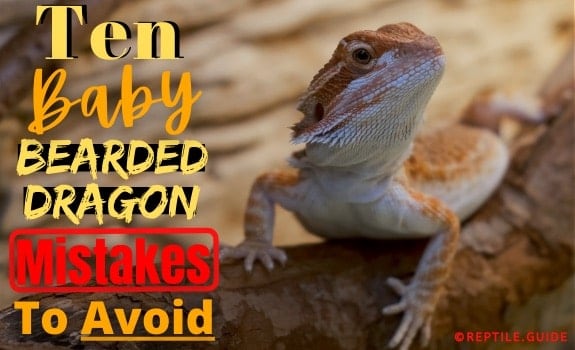While Bearded Dragons do make GREAT pets for beginner reptile enthusiasts, that doesn’t mean they’re foolproof!
Just like any other living animal, Bearded Dragons are worthy of careful thought and consideration, a commitment to learning, and an ongoing investment in their habitat and health.
It may all seem like a lot to take in – there are so many care sheets, guides, reviews, forum threads, social media groups, and more.
If you’re already here, though, that means you’re off to a great start. We’re here to discuss the 10 common Baby Bearded Dragon Care Mistakes New Owners Make, and more importantly, how to avoid them!
In This Article
Mistake #1: Impulse Buying
The number ONE biggest mistake that any new owner of any type of pet is prone to make is impulse purchasing.
Impulse purchases are likely to happen at pet stores and reptile expos, where well-meaning animal lovers may go to ‘window shop’ but then end up falling in love with an animal and bringing it home without doing any research or gathering supplies ahead of time.
Here are just some of the disadvantages of an impulse purchase:
- Your animal may be sick or have other health complications
- You might be overcharged and end up overpaying if the seller is taking advantage of the in-person “cute” factor
- You might be supporting a person or organization that’s unethical and hardly worthy of your business
- The breeder’s credibility is in question; Do they breeder breed selectively for healthy, robust animals and provide proper care to the babies before they go to their final home?
- You won’t know how large of an enclosure the animal needs and if you have the space
- You may find the animal’s dietary needs to be too complicated or difficult to cater to
- You won’t have the supplies on hand necessary for proper care and may not even be able to acquire them that day
- You won’t know for sure whether your interest will waver towards the animal in the future
Ideally, you should invest several hours of research into Bearded Dragon care prior to purchasing your animal. During your thorough research, you should pay special attention to husbandry, temperament, health, morphs, and sources before you purchase your animal.
There’s nothing like paying top-dollar for a “normal” animal that you will be committed to for the next 10 to 20 years, then finding out there is a cool morph that you wish you would’ve known about beforehand.
Or maybe you’d rather even own another species? The point is, You simply won’t know until you make an effort to learn about Bearded Dragons and other reptilian pets.
Additionally, Bearded Dragon babies are very sensitive to environmental conditions. If you bring home the animal on a whim, its habitat will not be ready. Enclosure temperature and humidity can take several days to regulate and fine-tune.
It would be a shame if you invested all of the money and effort into buying a baby Bearded Dragon, its home, and its supplies, only for it to become deathly ill because it was exposed to low temperatures for too long.
So, before you buy your Bearded Dragon baby:
- Do your research.
- Set up its enclosure several days ahead of time to ensure you have the right equipment to reach optimal conditions.
Mistake #2: Using Reptile Sand
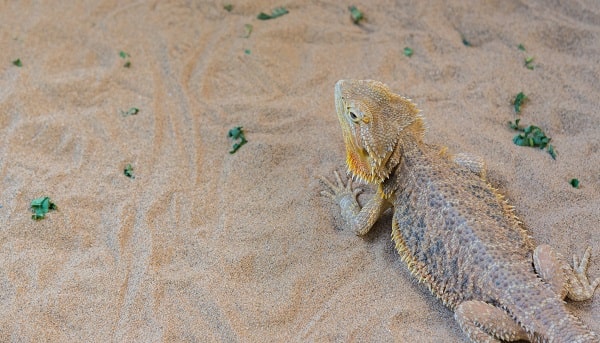
If Bearded Dragons are from the desert, that means they should live on sand, right?
False! Kind of…
Calcium sand, which is often marketed as “reptile sand,” is one of the leading causes of death for young Bearded Dragons.
These enthusiastic eaters will accidentally ingest the sand when they’re hunting insects. It will happen again and again until enough sand has built-up to cause an impaction.
The best-case scenario would be recovery after emergency surgery, while the worst-case scenario is death.
Fortunately, it’s easy to avoid this heartache… simply DON’T use calcium sand for your baby Bearded Dragon.
Great substrate alternatives are reptile-safe combinations of organic topsoil and play sand, harvested natural sand from Australia, reptile clay substrate, slate tile, and paper towels.
It’s important to note that Bearded Dragons are a burrowing species, so they will appreciate the opportunity to dig in a loose, safe substrate.
Mistake #3: Skimping on Supplies
Pet store employees are notorious for making poor and down-right dangerous product recommendations while you’re buying a pet.
Furthermore, if you have to buy everything at once and in person, you’re more likely to try to save money on the total bill by buying cheaper products – which may be of lower quality and less safe.
While you’re doing your research, it’s ESSENTIAL to pay attention to product guides and reviews so that you know what has worked for other Bearded Dragon baby owners.. and what hasn’t.
For example, there are numerous brands of reptile supplements and multivitamins on pet store shelves, but not all of them are made with the same quality – and some of them have even made Bearded Dragons ill.
In addition to buying trusted, high-quality product brands, you shouldn’t try to completely skimp on purchasing any of the necessary supplies, either.
Many new owners often convince themselves that these products aren’t essential, when in actuality, nothing could be further from the turth!
Necessary Bearded Dragon Supplies
At Least Two Thermometers and Hygrometers
Bearded Dragon babies require a thermal gradient, which means you need to continually be aware of both the high AND low temperature and humidity in the habitat at any given moment.
A Thermostat
Running any heating element without a thermostat is a recipe for disaster! You could end up burning your baby Bearded Dragon or even starting a house fire. A thermostat is NOT a replacement for a thermometer, and a thermometer is not a replacement for a thermostat.
Multivitamins and a Calcium Supplement
Commercially produced insects have nowhere near the same quality and amount of micronutrients as the insects that wild baby Bearded Dragons eat. To make up for these deficiencies, feeder insects should be periodically dusted with reptile calcium powder and multivitamin.
UV Lighting
A powdered Vitamin D3 supplement is no replacement for actual UVB lighting. Furthermore, many pet stores try to sell coil CFL UVB lights, but these don’t provide the level of UVB that baby Bearded Dragons need to thrive.
Make sure you develop a thorough understanding of what type of UVB lighting you need. If you splurge on any one item, this is the one – you have no way of telling if cheap, knock-off brands are putting out the proper wavelengths. A lack of these UV rays will make your baby Bearded Dragon sick.
Proper Sized Enclosure
Many new owners buy their tiny baby Bearded Dragon a little enclosure. And that’s fine at first…
You see, baby Bearded Dragons grow FAST, and you will actually spend more money if you start with a small enclosure and purchase upgrades as your pet grows than if you just buy a proper-sized adult enclosure in the beginning.
Mistake #4: Only Feeding Insects
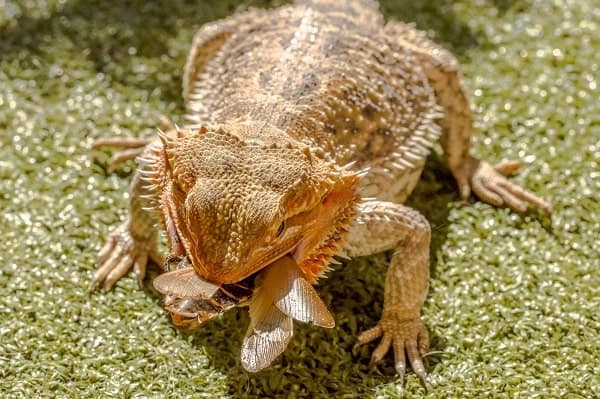
Uneducated pet store employees and reptile dealers may be convinced that baby Bearded Dragons are completely insectivorous; the only thing worse is when they spread that misinformation to unknowing new baby Bearded Dragon owners!
While it’s true that, at first, approximately 75% of their diet should consist of insects, baby Bearded Dragons NEED fresh, leafy greens as well.
Failure to offer these items in the beginning can cause you to end up with a very picky adult Bearded Dragon that only wants to eat bugs when they need a diet that consists of 80% plant matter to stay healthy!
Adult Bearded Dragons who eat too many insects become obese and have a shortened lifespan. The increase of vegetables in their diet also makes it easier to maintain proper calcium:phosphorus ratios.
Mistake #5: Forgetting the Vitamins
As we mentioned previously, calcium supplementation is necessary when feeding commercially produced feeder insects. Unfortunately, these bugs have unhealthy levels of phosphorus.
Your baby Bearded Dragon’s ideal dietary calcium:phosphorus ratio is 2:1.
Some feeder insects have higher levels of calcium. We’ll say it again: be sure to do your research! As a quick example, Dubia roaches have a 1:3 calcium:phosphorus ratio, while more commonly found crickets have a 1:9 ratio.
Another great example is Black Soldier Fly Larvae – with a 2.43:1 ratio, they’re almost perfect for most reptiles, and no calcium dusting is needed!
Recommendations range from dusting insects with calcium every-other feeding to once or twice per week. It’s going to depend on what type of feeder insects you use and how well you gut-load them.
Be sure to use a calcium supplement without vitamin D3 since you’ll be providing your baby Bearded Dragon with UVB lighting.
A reptile multivitamin is also a great idea, just to be sure all of your dragon’s nutritional needs are covered.
Mistake #6: Using the Wrong Lighting
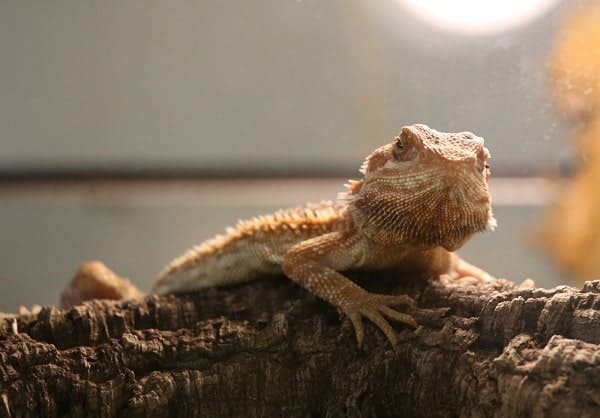
Did you know that baby Bearded Dragons require UVA and UVB lighting?
UVA light comes from just about any light source. If you’re providing a heat source that emits light, your baby Bearded Dragon will likely get all of the UVA he or she needs.
We recommend a halogen lightbulb for daytime heat and UVA exposure.
UVB, on the other hand, requires specifically made UVB-emitting lightbulbs, typically manufactured for reptiles. Still, not all UVB lightbulbs are created equal…
In fact, the type most commonly found in pet stores, coil ‘compact fluorescent’ lightbulbs, do not emit the intensity of UVB required by these desert-dwelling lizards.
Furthermore, the UVB light NEEDS to be mounted a specific distance from your baby Bearded Dragon’s designated basking spot.
Too far, and he or she will not get the UVB required for health and wellness. Too close, and it can cause health issues like photokeratoconjunctivitis.
The ideal distance is usually somewhere between 6″ and 18″, and it can take some creativity to devise the perfect set-up.
Finally, UVB lightbulbs need to be replaced at regular intervals – typically somewhere between every 6 and 12 months. Even if they still emit light, the quantity and quality of UVB produced declines with age.
Now you can see why it’s SO essential to conduct thorough research about the brand, model, and instructions of the lighting you use in your baby Bearded Dragon’s habitat!
Mistake #7: Buying A Small Enclosure
This practice isn’t necessarily a mistake, as long as you’re well aware of how often you’ll need to upgrade the enclosure and how big the final enclosure will need to be.
Sure, a hatchling Bearded Dragon can comfortably live in a 20-gallon long aquarium. But only for around a month, if that.
You might think you’re saving money by buying the smallest tanks possible, so next, you go for a 30-gallon aquarium. Except then you’ll need to upgrade, yet again, to a 50-gallon terrarium in a mere 2-3 months.
At the end of the day, by the time your Bearded Dragon reaches adulthood, you’re going to need a 4-foot long habitat.
We think it’s better to just buy that large enclosure at the beginning, which will save you money in the long-term and give your active baby plenty of space to run and exercise!
Mistake #8: Forced Handling
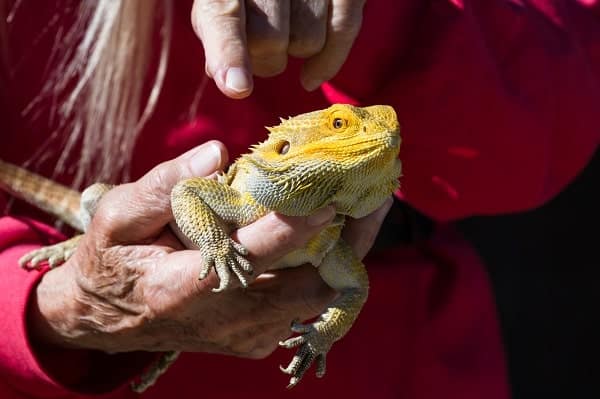
Many new baby Bearded Dragon parents.. especially ones who excitedly brought home an impulse-purchased animal.. are eager to handle their new pet.
But wait, stop right there!
You need to give your baby Bearded Dragon at least 7 days to settle into their new home, for starters.
Once 7 days have passed, and you know that your baby Bearded Dragon is eating well, drinking well, basking, and acting like a normal little beardie, you can begin the process of building trust and bonding with your lizard.
The key here is not to rush things. Forced handling and restraint can lead to your little dragon becoming even more nervous and afraid in your presence. As much as realistically possible, try to take things at his or her pace.
Spend as much time as you can within your baby Bearded Dragon’s line of sight. Sit still with your hand resting inside the enclosure – some baby Bearded Dragon’s are curious enough to come inspect the novelty on their own.
If your baby Bearded Dragon still seems uninterested, try offering mealworms or other grubs in the palm of your hand.
The wriggling is sure to attract your little dragon’s attention – and associating your hand and presence with food is an excellent step towards taming and bonding.
When you’re both ready, use your other hand to gently coax the Bearded Dragon onto your palm. If he runs away, try again tomorrow.
At first, it may be best to handle your Bearded Dragon while your hands are still in the enclosure. This will help your pet feel safer and prevent him from getting lost if he jumps off your hand.
Avoid squeezing your baby Bearded Dragon and reaching for him from above.
Mistake #9: Forgetting to Keep Records
We find that it’s incredibly beneficial and useful to keep detailed records when caring for exotic animals and reptiles like Bearded Dragons.
Wild animals are experts at hiding diseases and health issues because any outward signs of weakness would make them targets for predators.
Usually, the first clues are things that aren’t noticeable on a day-by-day basis unless you are tracking and recording them over the long term.
Some great things to track are:
- Appetite. How much is your Bearded Dragon eating?
- Activity level. How often, at what time, and for how long is your Bearded Dragon normally basking, sleeping, and hunting?
- Weight. It’s hard to visually tell when a Bearded Dragon loses a little weight, but the scale never lies!
- Defecation frequency. This one seems silly, but lack of feces is often one of the first signs of impaction or constipation.
Having a baseline for these items when your Bearded Dragon is healthy and normal may help you decipher when something bad may be going on, even if it’s not outwardly apparent.
Furthermore, if you need to take your Bearded Dragon to the veterinarian, they will likely take your pet’s history, including information regarding those items.
Nothing’s worse than the doctor asking you when your Bearded Dragon ate, and the only answer you can come up with is “a few days ago.”
Mistake #10: Co-Habitating
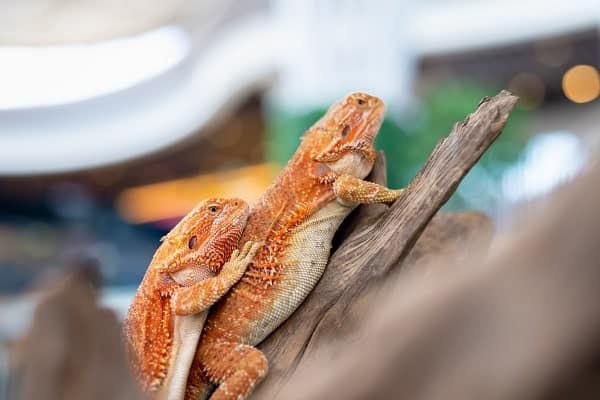
Inexperienced reptile owners may see a tank full of cute little baby Bearded Dragons and think to themselves that their new pet will want company, or maybe that it’s bonded to its sibling.
Unfortunately, this is NOT the case, and co-habitating, or housing more than one Bearded Dragon together, is almost always a bad idea.
While wild Bearded Dragons are semi-social animals, this is only because they have the space to establish individual micro-territories. There are always multiple hides, multiple basking sites, multiple food items, and multiple water sources in the wild.
A pecking order will be established in captivity, and the dominant animal will get priority access to every resource. Meanwhile, the submissive animal lives a stress-filled life, at best, and ends up being severely attacked in worst-case scenarios.
